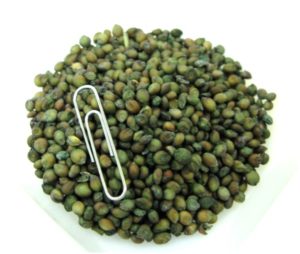Strychnine detected in a puppy
Travis Mays, MS, DVM
The Texas A&M Veterinary Medical Diagnostic Laboratory received stomach content, fresh kidney, and serum from a two-month old mixed breed puppy for testing. The owner found the puppy deceased in the yard with foam coming from its mouth. Malicious poisoning was suspected as a neighbor previously threatened to poison the owner’s puppies. Given the uncertainty associated with the source of possible poisoning, the owner elected to perform a general drug screen on the stomach content and histopathology on the kidney to rule out ethylene glycol intoxication.
Upon processing the stomach content for the general drug screen, analytical chemistry staff observed what appeared to be green-dyed milo seeds, consistent with those laced with strychnine used in some formulations of gopher bait (Figure 1). After making this discovery, the general drug screen and histopathology testing were canceled, and strychnine testing was performed on the stomach content. Strychnine was detected in the stomach content at an estimated concentration of 140 parts per million using high performance liquid chromatography (HPLC).
Strychnine is an alkaloid derived from the seeds and bark of the Strychnos nux-vomica tree (Figure 2). Its primary use is as a rodenticide however, it is often used maliciously to poison dogs. Strychnine is a potent convulsant, causing excitation of all parts of the CNS. With just a slight sound or touch, uncontrollable convulsions and seizures occur, followed by suffocation and death. Strychnine is a very toxic substance, with an approximate lethal dose of 0.75 mg/kg body weight in a dog.1
For more information about TVMDL’s strychnine test visit tvmdl.tamu.edu or call 1.888.646.5623.
References:
1 Gupta, Ramesh C. “Non-anticoagulant rodenticides: Strychnine.” Veterinary Toxicology, edited by Ramesh C. Gupta, Elsevier Inc., 2007, pp. 548-550.

